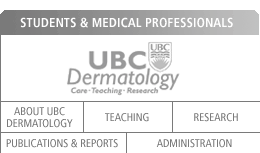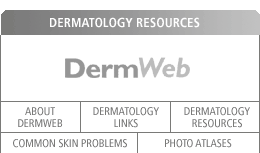|
|
 |
 |
 |
Birthmarks - 40 types
There are almost 40 different types of birthmarks. Approximately 10% percent of all children born in Canada and the United States are born with a type of vascular birthmark (involving blood vessels). While many of these congenital birthmarks will disappear within a few years of age, about ten percent of these birthmarks will need to be seen by a specialist. Some birthmarks appear as people grow older.
The following list describes some of the more common birthmarks and appropriate treatment. If you have a birthmark, please consult a dermatologist for a proper diagnosis and treatment plan.
Arteriovenous Malformation (AVM)
- Usually present at birth, but sometimes doesn’t appear until adulthood
- Can be acquired as a result of direct trauma
- Firm mass, soft when pressed, usually on lips, head, or neck
Treatment:
- Usually a combination of embolization and surgical excision.
|
Café au lait Spot
- Flat patches of a tan to light brown colour
- May occur anywhere on body
Treatment:
- Laser therapy may be effective to remove the coloration. The birthmark can recur in spite of treatment or the treatment may not work.
|
Cavernous Hemangioma
- Llumpy mass that is bluish or bluish-red in color
- The borders are not as visible as with other hemangiomas.
- Usually grows quickly during the first 6 months of age, then slows in growth, with most disappearing by 12 years of age
Treatment:
- Hemangiomas that don’t disappear are treated by differnent methods depending on their size and location
- Treatment method may be surgery, compression and massage, steroids, X-ray therapy, laser therapy, cryotherapy, or injection of hardening agents
|
Congenital Pigmented Nevi
- Can vary from light brown to almost black moles, may be hairy
- Small moles are much more common than large moles, and as such large moles should be tested for cancer
|
Treatment:
- Is surgical removal depending on size and location. The excision could leave a scar.
|
Hemangioma
- Most occur on the head and neck area, and are reddish in color.
- Occur 5 times more often in girls and women
- Some visible at birth, or from 1-4 weeks after birth
- May grow for 18 months, and then start to fade for 3-10 years
- A few can be life threatening, especially internal hemangiomas, but some require no treatment and shrink with time
- A full body scan should be done if more than three are present
|
Treatment:
- Observation
- Laser may help remove remaining evidence of the lesion
|
Lymphatic Malformation
- Enlarged lymphatic vessels due to excess fluid
- Although it can occur anywhere on body, it is most common in head and neck area, and can increase and grow
- Leakage from skin can occur, and face will swell if lymph vessels in face are affected
- Diagnosis can utilize MRI and CAT scans
|
Treatment:
- Laser therapy
- Sclerotherapy
- Surgery
|
Mongolian Spot
- Lesions resemble bruises, being slate grey or blue in colour
- Common in darker skinned babies found on back, buttocks, and sometimes shoulders and legs usually fades over time
Port Wine Stain or Nevus Flammeus
- Most appear at birth, and can be anywhere on the body
- Are red or purple in color, and can be slightly raised or flat
|
Treatment:
- Laser treatment can be used to reduce color and to improve the skin texture
|
Salmon Patch or Nevus Simplex
- Salmon-colored mole, usually found on the nape of the neck, but can appear on forehead, upper eyelids, or around the mouth and nose
- Also referred to as “angel kiss” or “stork bite”
- More than 95% lighten and fade completely.
|
Treatment:
- No treatment usually required
|
Strawberry Hemangioma
- Red, soft, and raised, as a result of malformation of the blood vessels
- Present at birth or shortly thereafter
- Size can vary – will grow, but usually fades and disappears between the ages of 5-10
|
Treatment:
- Depends on size and location of lesion, treatment is one or more of following:
- Laser therapy, or injection of agents which destroy the blood vessel
|
Venous Malformation
- Abnormality of the large deep veins, soft to the touch
- When lesion is compressed the color disappears and empties
- Can be superficial or deep - deep variety can be colourless but shows a protruding mass
- Most common areas they are found are the jaw, cheek, lips and tongue
- Slow, steady growth – rapid growth can be caused by serious sickness, trauma, infection, hormone changes
|
Treatment:
- Full removal is recommended
|
Venous Stain
- Flat birthmark, bluish in color
- Comprised of enlarged blood vessels, especially those smaller veins that join capillaries to larger veins
- Sometimes pressure cysts can appear and may pop and bleed
« Back to Common Skin Disorders
modified 011308 |
|
 |
|

